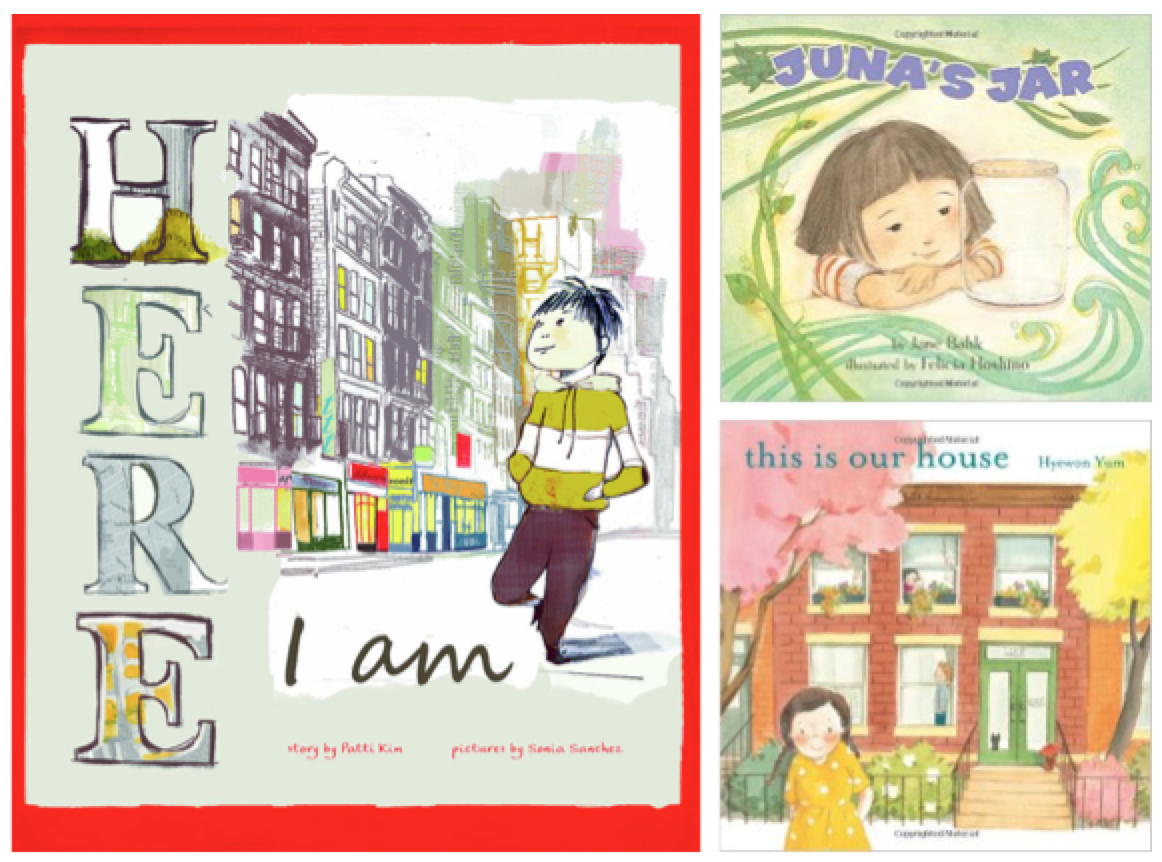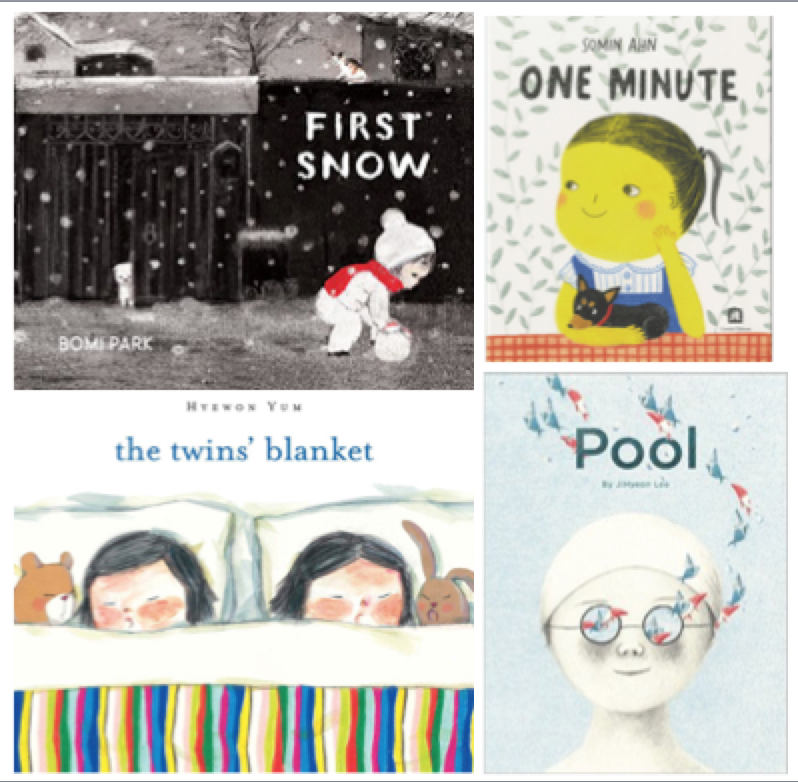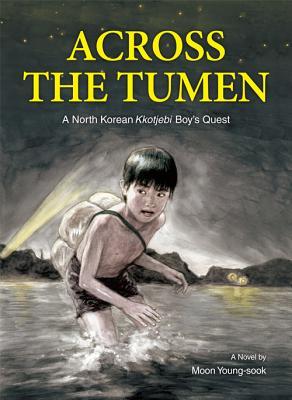By Yoo Kyung Sung, University of New Mexico,
and Junko Sakoi, Tucson Unified School District
Most of the stories of Korean-Americans and Korean immigrants are products of the ’90s and 2000s. Ae-Kyung’s Dream (1988) by Min Paek is the only picture book of a Korean immigrant child’s story published in the 1980s. Picture books and chapter books of U.S. Korean groups present different experiences and stories of immigration and integration. The majority of transnational Korean children’s books are either exploring new immigration experiences or following Korean-American children’s journeys of developing their bicultural identities (Sung, 2009).

Few universal books in which the main character happens to be Korean illustrate a universal theme. On the other hand, universal-theme books do not illustrate specific cultural experiences. Many books that discuss U.S. Koreans’ experiences tend to focus on struggles to develop bicultural identities as Korean or American, rather than a broader theme.
Then, what are the new, positive patterns? We noticed three different, positive changes in transnational Korean children’s books: 1) the implications of cross-cultural peer relationships, 2) works of new Koreanness, and 3) the translation of Korean children’s novels into English. These patterns address the problem of insufficient contemporary voices, brought on by abundant Korean folklore stories. All of the following books are contemporary realistic fiction.
Implications of cross-cultural peer relationships
Some U.S. Korean books minimize peer ranges between the Korean character and another white characters. The Name Jar (2001) by Yangsook Choi, Yoon and the Jade Bracelet (2008) by Helen Recorvits, and Good-bye, 382 Shin Dang Dong (2002) by Frances Park tell stories that do not have other significant multiethnic peer characters. The newer books have started to broaden the popular concepts of “American” peers and their roles in stories.
Title: Juna’s Jar (2015)
Author: Jane Bahk
Juna’s best friend, Hector, moves away unexpectedly. Juna talks to Hector’s Abuela and finds out that Hector no longer lives with his Abuela. With the sudden absence of her best friend, Juna learns to play by herself with the empty kimchi jar, which Juna and Hector used to play with. Juna grows and discovers her self-resilience after the changes in her peer relationship. Hector and his grandma make an important cross-cultural implication in Juna’s community.
Title: Here I Am (2013)
Author: Patti Kim; Illustrator: Sonia Sanchez
A wordless book of a new immigrant boy. Even though the book doesn’t “say” the boy is from Korea (though author’s note says she is from Busan, Korea), the traditional house of his home country in an illustration implies he is from Korea. Languages in the air and texts are all reminders of his being in new place, New York City. He gradually adjusts to his new space and landscape. During his adjustment, an African-American girl plays important role for him to finally think, “Here I am.”
Title: This is Our House (2013)
Author: Hyewon Yum
This story recognizes immigrant’s history through additional perspectives. Because Korean-American identities are emphasized through family history, This is Our House shows what it means to be Korean-American through intergenerational perspectives. Illustration of a Korean family member marrying a white man is rare in picture books, but this book adds that realistic and authentic cross-cultural portrayal of a family expansion.
Works of New Koreanness
Newer books do not specifically project Korean cultures through typical traditions but universal experiences. It is because of most of them are from present Korea. Originally it wasn’t written for the U.S. audiences. Books for Korean children don’t need to project Korean identity through traditions but childhood connections. Korean protagonist’s days in these books are not different from children in ordinary communities. And universality is pursued through artistic styles that readers wouldn’t guess any Korean connection by looking at illustration. It also mirrors contemporary art styles in Korean picture book industry.

Title: First Snow (2016)
Author: Bomi Park
This poetic and imaginative story follows a girl on her first snow day, where she hides outside and tries playing with snow for fun.
Title: One Minute (2016)
Author: Somin Ahn
In one minute what can happen? In English language, “second” and “ minutes” are used differently for “quickly” or “ as soon as possible” in common interactive contexts. This book invites young readers to think of one minute concept.
Title: Pool (2015)
Author: Jihyeon Lee
In this wordless book of a boy and a girl meeting at a noisy swimming pool, two children dive deep into the bottom of the pool. Later they can see each other without swimming goggles and become friends without saying a word. The shared adventure at the bottom of the swimming pool forms a strong foundation for their new friendship.
Title: The Twins’ Blanket (2011)
Author: Hyewon Yum
A set of twins shared their blanket when they were young without a problem. Now the blanket feels too small to share as their bodies grow. This story explores sibling competitions and friendship.
Title: Mom, It’s My First Day of Kindergarten (2012)
Author: Hyewon Yum
Hyewon Yum, a rising star in children’s literature, conveys a universal theme through her characters. Children all over the world understand the first day of kindergarten experiences that she illustrates in this children’s book.
Translated Korean Children’s Chapter Books
Over the years, the number of Korean picture books republished in the U.S. has increased. However, not a single children’s novel had been translated for a long time. Finally, last year, a powerful book demands attention was published as the first chapter book for young readers in the U.S. Even though this is the only chapter book published domestically so far, we hope more Korean chapter books are translated and available for U.S. audiences.

Title: Across The Tumen (2013/2015)
Author: Young-sook Moon
North Korea, one of the most stereotyped and controversial countries in the world, remains a mystery to many people. This story follows Young Dae and his family as they cross the Tumen, the river on the border between China and North Korea. The family must leave North Korea in order to live, and they reunite in South Korea after endless transnational travels. Across the Tumen was published in Korea in 2013 and republished in English language in 2015.
Next week we will discuss new trends and changes in books about Japanese cultures and people.
Reference
Sung, Y. K. (2009). A Post-Colonial Critique of the (Mis)Representation of Korean-Americans in Children’s Picture Books. Tucson, Ariz.: University of Arizona.
Journey through Worlds of Words during our open reading hours: Monday through Friday 9 a.m. to 5 p.m., Saturday 9 a.m. to 1 p.m. Check out our two online journals, WOW Review and WOW Stories, and keep up with WOW’s news and events.
- Themes: Junko Sakoi, Korean Children's Literature, Yoo Kyung Sung
- Descriptors: Books & Resources, Debates & Trends, WOW Currents
